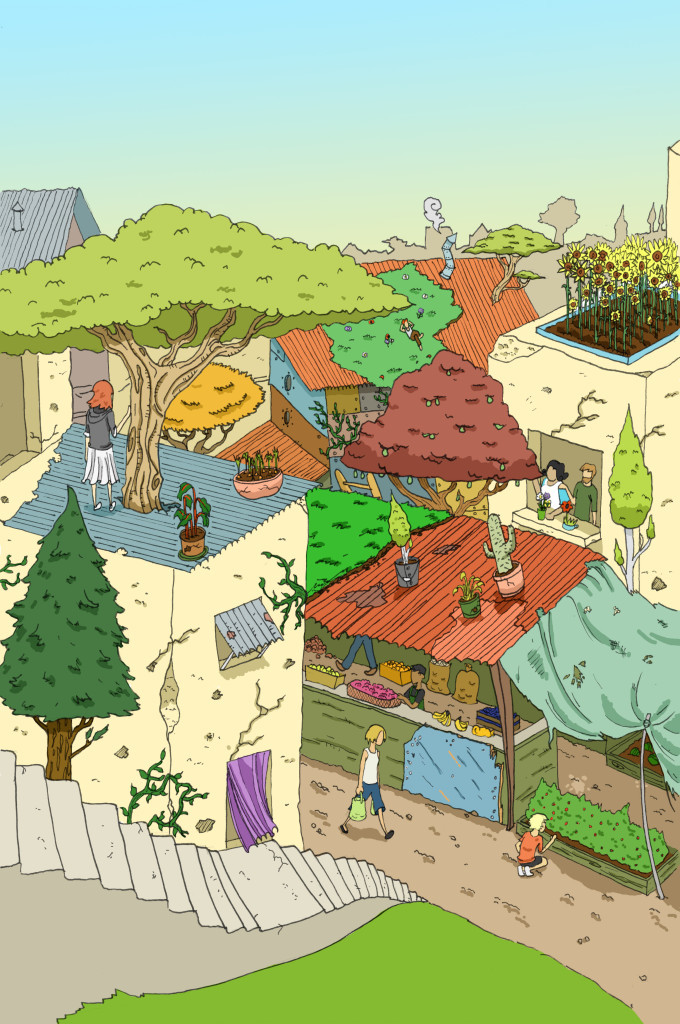Urban gardening for the broke and backyardless
By Sharon Miki, Assistant Editor
[dropcap]G[/dropcap]ardening ain’t just for grandma anymore.
As the seasons sway into spring and hunger pangs rumble in the proverbial tummies of college students everywhere, the natural inclination is to trade in nutritious-yet-expensive, fresh, local organic produce for cheap frozen burritos and Tanqueray. Is there not a better way to live?
While I doubt many of us have the resources to harvest enough crops to sustain us entirely, with a little planning and preparation it is most definitely possible to grow a little garden and—in the long term—maybe even save a little green. Whether you’ve squished your collegiate self into a tiny shoebox in the sky or you’re dwelling in the underground depths with the basement people, ample land for harvesting might be closer than you think. The key to growing your own delicious and nutritious foodstuffs and oxygen-enhancing vegetation might just be in your own backyard—even if you technically don’t have a backyard. But how can you get started?
[hr]
Urban Gardening
Executive director of the Vancouver-based non-profit organization City Farmer Michael Levenston spoke to The Other Press about the keys to growing in small spaces. Levenston and City Farmer (www.cityfarmer.info), have worked to encourage and help people grow food in the city for the past 34 years.
No matter where you live, Levenston explains that the keys to successful gardening are simple: sunlight, good-quality soil, and the desire to grow.
“[Urban gardening] isn’t hidden. I think the hidden thing is the awareness that people can do it—that they can get started,” Levenston says, noting that once you have the supplies, it’s easy to find help, whether it’s online, through YouTube, through books, from classes (City Farmer offers free city gardening demonstrations in Vancouver), or from just talking to someone. “Try something, talk to anybody around and you’ll find that someone you know has a green thumb and is ready to help you.”
Once you’ve made the decision to start growing, you must decide which method of urban gardening best fits your situation. Urban gardening can cover a lot of, well, ground, but for our purposes, we will use the term for refer to container or apartment gardening, and community gardening. Each of these avenues allow the space-limited to plant and enjoy a garden in some form.
[hr]
Apartment Gardening
“If you can put dirt in it, you can grow something in it,” urban gardener Lindsey Klock told The Other Press while tending her window garden of succulents—water-retaining plants like aloe and cacti that flourish indoors during winter months.
Klock, who has been apartment and balcony gardening year-round for about three years, noted the multiple values of urban gardening for the young and broke. “First of all, for students, gardening is a great, productive way to procrastinate. It’s amazing stress relief.”
Also, aside from the therapeutic benefits, she explains the more practical advantages to the hobby: “There’s something super satisfying about living in a small apartment and picking fresh food from your patio. When it comes to balcony gardening, sure, it’s definitely lesser quantities—but it’s amazing when you’re shown what it takes to get a few pounds of something. It makes you appreciate your food more.
“But it definitely tastes better…you pick a strawberry off your plant and eat it and it’s incredible. You’re not eating genetically-modified fruit—you’re eating the actual fruits of your labours.”
For Klock, the secret to urban gardening on a tight budget is to be resourceful and inventive with your supplies. “If you plan and look around, you can do almost everything for cheap. Just be creative to find ways to recycle things for free.” Indeed, Klock’s small Vancouver apartment is rich with the kitsch of imaginative gardening. Even in still-chilly early March, the space is strikingly alive, with greenery dispersed throughout the indoor and outdoor space in everything from mason jar terrariums to handcrafted vessels to planters abandoned on the street.
Klock gets most of her gardening supplies from the dollar store (where she picks up seeds and tools), from Craigslist (“cheap balcony stuff from rich people who don’t want it anymore”), and from friends’ clippings.
“If you see something that someone else has, don’t be shy to ask for a clipping,” Klock says. Clippings, or small pieces of an existing plant, can be planted in your garden to create your own—at no cost. “Clippings work especially well for viney-type plants.”
When it comes to soil, Levenston and Klock both agree that quality is important—and often one of the larger costs associated with container gardening. If you’re not squeamish, however, Douglas student Karin Keefe recommends composting your food scraps to make your own rich, quality soil.
[hr]
Community Gardening
If you don’t want to plant in containers—but don’t have any space—community gardens might offer an alternative way to grow.
Community gardens are neighbourhood gathering places that are increasingly popular in Metro Vancouver, where land for hobbyist agriculture is often at a minimum. These park-like areas offer residents the opportunity to plant and maintain a small plot of land in their community.
While community gardens offer pre-made plots to garden in, they can be difficult to get into because they’re so popular. According to the City of Vancouver Community Services page, “Currently, the demand for community garden plots in Vancouver far exceeds the number of plots that are available.” So, if you’ve got your heart set on gardening in a plot, it’s best to contact your local community garden and inquire about spots and waitlists.
[hr]
No-Fail Crops for Beginners
So, you’re set up and ready to grow—but the last time you tried to care for a plant, your mom’s fern turned pink. What to grow?
“If you’re brand new at it, start simple,” Levenston advises, noting that the easiest place to start is with the makings of a good salad. “Lettuce, greens—many types of lettuce are easy to grow. Also chives [and] small green onions.” Similarly, based on her balcony garden experience, Klock recommends other hard-to-screw-up harvests include cherry tomatoes, berry plants, peas, and most herbs.
Aside from fruit and vegetable crops, growing hardy plants like vines and cacti might improve your gardening practice and confidence, while also beautifying your living space during exams.
The real key to starting simple, however, might have more to do with how you grow than what you grow. Levenston stresses the importance of a solid base of healthy, good soil and lots of light. Once your growing bases are covered, you don’t have too get overly ambitious with seeds; although successfully growing plants from seeds might be the cheapest strategy, you can also get bedding plants (basically, baby versions of your plant) from the nursery and transplant them into your soil, where they will grow.
[hr]
Timing’s Everything
There’s no better time than now to start your garden, but certain things grow best in certain conditions and times of the year. Klock advises starting the year by planting bulbs for spring flowers. “Things like crocus’ and tulips will come up from the bulbs, and when they’re done, you can pull them up, store them, and reuse them next year. I keep mine in an old coffee can when they aren’t in the ground, so you save a lot of money by not buying that sort of thing every year.”
In late-March and April, after the last frost has left town, you can start planting warm season vegetables like tomatoes and peppers. Still, if you don’t get the timing down perfectly, don’t freak out.
“The thing to remember when you first start is to be patient,” Klock advises first-time growers. “If something doesn’t turn out, that’s okay.
“I do a lot of trial and error. I mean, obviously college students aren’t our grandparents, so we probably haven’t been gardening for 40 years. Don’t worry if something doesn’t work out, and just enjoy the spoils.”



